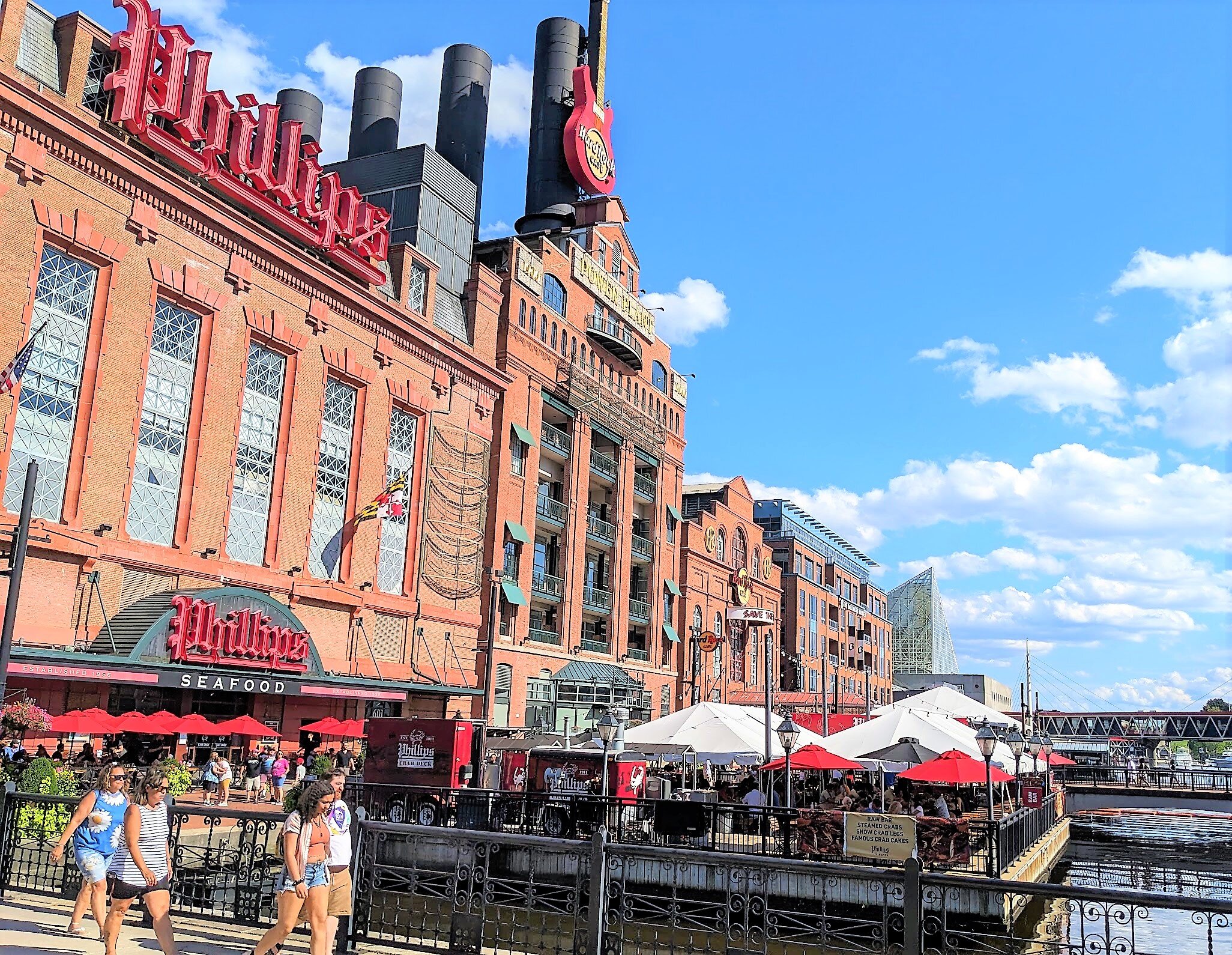Baltimore's Harbor Area Still Sets the Standard for U.S. Cities
Since the 1960s, aging industrial cities in the United States have been striving to reinvent themselves as entertainment and lifestyle destinations by redeveloping their waterfront areas and attracting residents and visitors to leisure activities downtown. The model for these efforts has been the Inner Harbor project in the historic city of Baltimore, Maryland, which has been winning awards for urban design and architectural achievement since the 1980s. Baltimore’s package of maritime attractions, museums, performance venues, shopping and restaurant facilities, sports complexes, and high-end residential projects set a high standard. Despite ongoing struggles with urban blight, crime, and the decline in retail activity, the city is actively working with private and public stakeholders around the harbor to continue these revitalization efforts.
The activities offered in the Inner Harbor are spread out around miles of waterfront, but most can be easily reached on foot. This article will focus on the central themes and activities which people enjoy there.
Historic Piers, Naval Vessels, and Fort McHenry
At the center of the Inner Harbor are the remnants of six piers which served as dockyards and warehouses for the city’s commercial shipping industry in the days before container cargo ships. Today, the renovated piers jut out into the harbor and are filled with parks and benches, performance venues, eateries, and museums. Connectivity is a central theme of the Inner Harbor layout. Promenade walkways and pedestrian bridges provide visitors with convenient ways to walk from pier to pier as do the water taxis around the harbor. Another theme of the pier area is to promote the Naval History of the region. Ever since Baltimore hosted a fleet of tall ships during the 1976 Bicentennial celebrations in the United States, historic vessels have been on display there. Most impressive is the 207-foot-long USS Constitution, a 44-gun frigate, which served in the War of 1812 against the British and was used for training cadets at the Naval Academy during the Civil War. It is fun to explore the captain's quarters and gun deck on this vessel or to tour the submarine USS Torsk, a United States Coast Guard Cutter, and a light ship used in the Chesapeake Bay.
Father out in the bay is another structure which played an important role in United States history. Fort McHenry and its predecessor Fort Whetstone was one of the structures which guarded Baltimore's important harbor during the Revolutionary War and the War of 1812, withstanding a severe bombardment from British forces in 1814. Now it serves as a National Monument and Historic Shrine. It commemorates the story of Francis Scott Key, who wrote the words to The Star-Spangled Banner while watching a battle take place above the fort.
Entertainment Venues
Throughout the redevelopment of the Inner Harbor, the Pratt Street Power Plant building located on Pier 4 has been at the center of the action. This turn of the century generating structure was first used as an indoor Six Flag attraction, and then as an ESPN Zone sports club, until being converted into restaurant and office uses. The building is now the headquarters of a popular Hard Rock Café and the Phillips Seafood restaurant and waterfront café. Do not miss Lucky’s ice cream shop right along the promenade either. Only three short blocks to the north, there is another prominent entertainment district that consists of a group of bars, entertainment and restaurant uses. Power Plant Live! focuses on providing live music venues in nightclubs and beer gardens settings along with fun attractions such as an ax throwing club and an escape room challenge. Finally, other sections of the Inner Harbor feature live comedy performances and street performers.
Sports Facilities
Another key ingredient in the success of Baltimore's Inner Harbor has been the construction and operation of the Camden Yards Sports Complex nearby. Oriole Park at Camden Yards, which is the home of the Baltimore Orioles, has been widely recognized as one of the most attractive and fan friendly baseball venues in the country. Coupled with M&T Bank Stadium next door used for NFL games by the Baltimore Ravens, these two facilities attract almost three million people to downtown Baltimore who ordinarily might not visit the city. Once there, these fans book rooms at the many downtown hotels in the area and explore the other attractions of the Inner Harbor.
Museums
Museums are interspersed among the food and entertainment venues of the Inner Harbor. Baltimore was one of the first cities to develop a world class Aquarium on its harbor. This e structure contains thousands of ocean species including sharks, dolphins, exotic fish, and crocodiles. Another science-oriented venue is the Maryland Science Center which focuses on providing interactive and educational experiences for young people on subjects involving the human body astronomy, and physics. The IMAX theater and rooftop observatory allow for major science films to be exhibited along with talks about space. Closer to home, the Inner Harbor has retained a sense of its history by featuring Industrial activities at the Baltimore Museum of Industry and train exhibits at the B&O Museum and roundhouse.
Future Enhancements
Baltimore's Inner Harbor has struggled at times to attract a steady stream of visitors and tenants. In addition, established attractions are constantly challenged by the need to reinvent themselves periodically to appeal to changing public tastes. One way the city has responded is to establish a high-end residential area called Harbor East to the east of the Inner Harbor properties. So far, younger people have been flocking to relocate to this part of the city and their presence has provided a source of new patrons for the attractions, restaurants, and retail businesses within the Inner Harbor community as well. Consequently, the outlook for the Inner Harbor region as it enters its fifth decade of existence remain strong.





